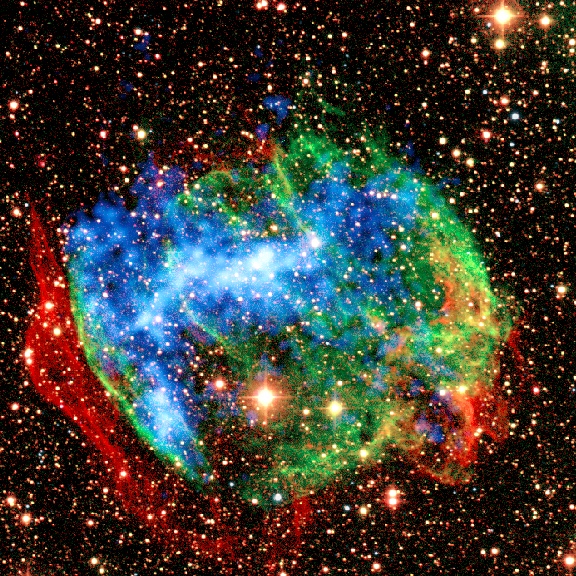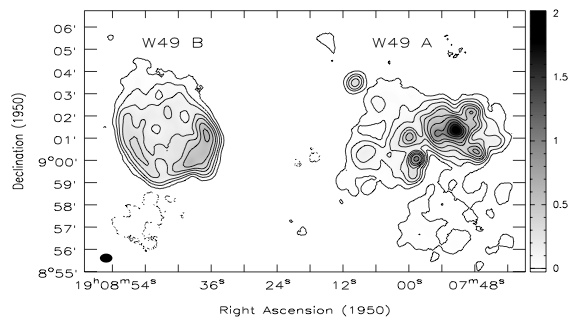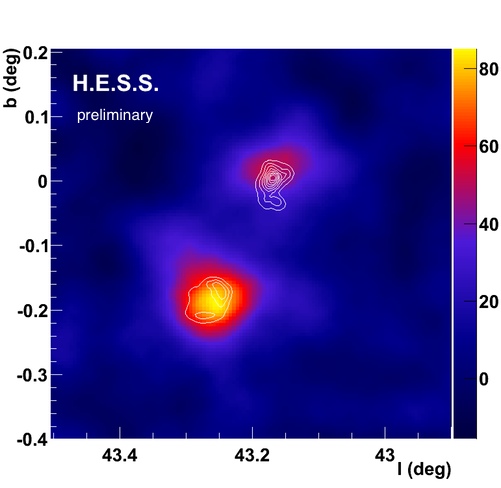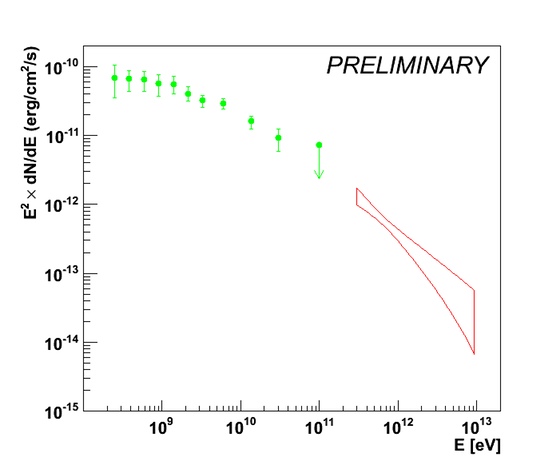Very high energy gamma rays from the W49 region
December 2010

The W49 region hosts two bright radio sources (Fig. 1): the star forming region W49A and the supernova remnant W49B. The million solar mass Giant Molecular Cloud W49A is one of the most luminous giant radio HII regions in our Galaxy and hosts numerous active, high mass star formation sites embedded a 50 light year region. The supernova remnant W49B (top image) stands out among remnants of this type due to its high radio surface brightness; it is also one of the brightest ejecta-dominated remnants in X-rays. W49B lies at a distance of about 30000 light years (Brogan & Troland 2001), has an estimated age of a few 1000 years and appears at a size of 4 minutes of arc. W49B's progenitor was a super-massive star located in a dense molecular cloud; the stellar wind of this star drove a wind cavity into the cloud and the explosion occured in this cavity (Keohane et al. 2007). The unusual barrel-shape of the W49B remnant has led Ioka et al. (2004) to suggest that it represents a remmant of a gamma-ray-burst explosion, resulting in two highly-relativistic jets, with the X-ray emission (top image) tracing the jets up to the point where they hit the cloud at the edge of the cavity and cause X-ray emission to flare out. Even without this speculative scenario, which predicts a degree-wide source of hard gamma rays, the relatively young age of the remnant combined with its embedding in a cloud serving as target for gamma-ray production by cosmic rays accelerated in the supernova shock make this a promising target for gamma ray observations, and indeed W49B was observed by H.E.S.S. as early as 2005. The first detection in gamma rays was, however, reported at GeV energies by Fermi (Abdo et al. 2010).
About 60 hours of observations accumulated by H.E.S.S. combined with advanced analysis techniques have now resulted in the detection of W49B as - at the scale of the H.E.S.S. resolution of about 5 minutes of arc - point-like source of TeV gamma rays, with a statistical significance of 8.8 sigma and a flux equivalent to 0.5% of the Crab Nebula flux (Fig. 2). The energy spectrum of gamma rays is rather steep, with a spectral index of about 3 between 0.3 TeV and 10 TeV, and matches smoothly with the lower-energy spectrum by Fermi (Fig. 3). Gamma-ray emission from the direction of W49A is also indicated for the first time, at a significance in excess of 4.4 sigma (Fig. 2). The gamma-ray signal is coincident with the densest part of the molecular cloud.
Since the supernova shock of W49B is observed to be interacting with the molecular cloud in which the supernova exploded, the detection of W49B at GeV and TeV emission is a strong indication for a hadronic nature of the accelerated particles. In case of W49A, shocks created by the strong winds of numerous massive stars provide a plausible mechanism for particle acceleration. Recently, evidence for the presence of two expanding shells in W49A with an energy in the 10^49 erg range was found by Peng et al. (2010), providing an appropriate source of energy.
Reference: H.E.S.S. collaboration, F. Brun et al., poster at the 25th Texas Symposium on Relativistic Astrophysics, Heidelberg, 2010.


